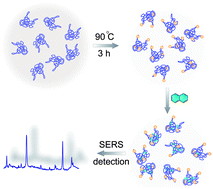Humic acids-based one-step fabrication of SERS substrates for detection of polycyclic aromatic hydrocarbons†
Abstract
A facile one-step approach to fabricate substrates for surface-enhanced Raman scattering (

* Corresponding authors
a
State Key Laboratory of Bioreactor Engineering & Department of Chemistry, East China University of Science and Technology, Shanghai 200237, China
E-mail:
ytlong@ecust.edu.cn, daweili@ecust.edu.cn
b
School of Chemistry, University of Birmingham, Edgbaston, Birmingham, England, UK
E-mail:
j.s.fossey@bham.ac.uk
A facile one-step approach to fabricate substrates for surface-enhanced Raman scattering (

 Please wait while we load your content...
Something went wrong. Try again?
Please wait while we load your content...
Something went wrong. Try again?
L. Qu, Y. Li, D. Li, J. Xue, J. S. Fossey and Y. Long, Analyst, 2013, 138, 1523 DOI: 10.1039/C2AN36764E
To request permission to reproduce material from this article, please go to the Copyright Clearance Center request page.
If you are an author contributing to an RSC publication, you do not need to request permission provided correct acknowledgement is given.
If you are the author of this article, you do not need to request permission to reproduce figures and diagrams provided correct acknowledgement is given. If you want to reproduce the whole article in a third-party publication (excluding your thesis/dissertation for which permission is not required) please go to the Copyright Clearance Center request page.
Read more about how to correctly acknowledge RSC content.
 Fetching data from CrossRef.
Fetching data from CrossRef.
This may take some time to load.
Loading related content
